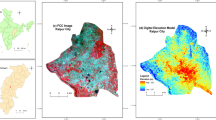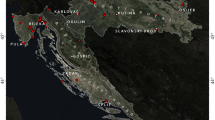Abstract
The operational Asian Dust Aerosol Model (ADAM)1 in Korea Meteorological Administration has been modified to the ADAM2 model to be used as an operational forecasting model all year round not only in Korea but also in the whole Asian domain (70-160°E and 5-60°N) using the routinely available World Meteorological Organization (WMO) surface reporting data and the Spot/vegetation Normalized Difference Vegetation Index (NDVI) data for the period of 9 years from 1998 to 2006. The 3-hourly reporting WMO surface data in the Asian domain have been used to re-delineate the Asian dust source region and to determine the temporal variation of the threshold wind speed for the dust rise. The dust emission reduction factor due to vegetation in different surface soil-type regions (Gobi, sand, loess, and mixed soil) has been determined with the use of NDVI data. It is found that the threshold wind speed for the dust rise varies significantly with time (minimum in summer and maximum in winter) and surface soil types with the highest threshold wind speed of 8.0 m s−1 in the Gobi region and the lowest value of 6.0 m s−1 in the loess region. The statistical analysis of the spot/vegetation NDVI data enables to determine the emission reduction factor due to vegetation with the free NDVI value that is the NDVI value without the effect of vegetation and the upper limit value of NDVI for the dust rise in different soil-type regions. The modified ADAM2 model has been implemented to simulate two Asian dust events observed in Korea for the periods from 31 March to 2 April 2007 (a spring dust event) and from 29 to 31 December 2007 (a winter dust event) when the observed PM10 concentration at some monitoring sites in the source region exceeds 9,000 μg m−3. It is found that ADAM2 model successfully simulates the observed high dust concentrations of more than 8,000 μg m−3 in the dust source region and 600 μg m−3 in the downstream region of Korea. This suggests that ADAM2 has a great potential for the use of an operational Asian dust forecast model in the Asian domain.















Similar content being viewed by others
References
Duchmin B, Maisongrande P, Dedieu G, Leroy M, Roujean JL, Bicheron P, Hautecoeur O, Lacaze R (2000) A 10-day compositing method accounting for bidirectional effects. Proceedings of the VEGETATION 2000: 313-318, Belgirate, Italy
Dudhia J, Grill D, Guo Y-R, Hausen D, Manning K, Wang W (1998) PSU/NCAR mesoscale modeling system tutorial class notes (MM5 modeling system version 2)
Gillette DA (1981) Production of dust that maybe carried great distances. Spec Pap Geol Soc Am 186:11–26
Grell GA, Dudhia J, Stauffer DR (1994) A description of the 5th generation Penn State/NCAR mesoscale model (MM5). NCAR TECH. Note NCAR/TN-398, 117 pp
Huang S, Siegert F (2006) Land cover classification optimized to detect areas at risk of desertification in North China based on SPOT VEGETATION imagery. J Arid Environ 67:308–327
Husar RB, Tratt DM, Schichtel BA, Falke SR, Li F, Jaffe D, Gassó S, Gill T, Laulainen NS, Lu F, Reheis MC, Chun Y, Westphal D, Holben BN, Gueymard C, McKendry I, Kuring N, Feldman GC, McClain C, Frouin RJ, Merrill J, DuBois D, Vignola F, Murayama T, Nickovic S, Wilson WE, Sassen K, Sugimoto N, Malm WC (2001) Asian dust events of April 1998, J Geophys Res 106(D16):18317-18330, 10.1029/2000JD900788
In H-J, Park S-U (2002) A simulation of long-range transport of Yellow Sand observed in April 1998 in Korea. Atmos Environ 36:4173–4187
In H-J, Park S-U (2003) The soil particle size-dependent emission parameterization for an Asian dust (Yellow Sand) observed in Korea on April 2002. Atmos Environ 37:4625–4636
Kerr JT, Ostrovsky M (2003) From space to species: ecological applications for remote sensing. Trends Ecol Evo 18:299–305
Lee E-H, Park S-U (2005) A numerical simulation of an Asian dust (Hwangsa) event observed in Korea on March 10-12, 2004 using the modified ADAM model. Adv Geosci 5:67–76
Lu L, Li X, Huang CL, Ma MG, Che T, Bogaert J, Veroustaraete F, Dong QH, Ceulemans R (2005) Investigating the relations between ground-measured LAI and vegetation indices in an alpine meadow, north-west China. Int J Rem Sens 26(20):4471–4484
Marticorena B, Bergametti G (1995) Modeling the atmospheric dust cycle: 1 Design of a soil-derived dust emission scheme. J Geophys Res 100:16515–16430
Park S-U, In H-J (2003) Parameterization of dust emission for the simulation of the Yellow Sand (Asian dust) observed in March 2002 in Korea. J Geophys Res 108, (D19) 4618, doi:10.1029/2003JD00348.
Park S-U, Lee E-H (2004) Parameterization of Asian dust (Hwangsa) particle-size distributions for use in dust emission model. Atmos Environ 38:2155–2162
Park S-U, Lee E-H (2005) A numerical simulation of an Asian dust event observed in Korea on 20-22 April 2005 with the ADAM2 model, Proceedings of 11th International Joint Seminar on Regional Deposition Processes in the Atmosphere, November 23-25 2005. Jeju, Korea
Pettorelli N, Vik JO, Mysterud A, Gaillard JM, Tucker CJ, Stenseth NC (2005) Using the satellite-derived NDVI to assess ecological responses to environmental change. Trends Ecol Evo 20:503–510
Telesca L, Lasaponara R (2006) Vegetation patterns in burned and unburned areas investigated by using the detrended fluctuation analysis. Physica A 368:531–535
Thaim AK (2003) The causes and spatial pattern of land degradation risk in southern Mauritania using multitemporal AVHRR-NDVI imagery and field data. Land Degrad Dev 14:133–142
Tucker CJ, Dregne HE, Newcomb WW (1991) Expansion and contraction of the Sahara Desert between 1980 and 1990. Science 253:299–301
Wang Q, Adiku S, Tenhunen J, Granier A (2005) On the relationship of NDVI with leaf area index in a deciduous forest site. Rem Sens Environ 94:244–255
Weiss JL, Gutzler DS, Coonrod JEA, Dahm CN (2004) Long-term vegetation monitoring with NDVI in a diverse semi-arid setting, central New Mexico. J Arid Environ 58:249–272
Westphal DL, Toon OB, Carlson TN (1987) A two-dimensional Investigation of the dynamics and microphysics of Saharan dust storms. J Geophys Res 92:3027–3049
Wu B, Liu C (2000) Crop growth monitor system with coupling of AVHRR and VGT Data, Vegetation 2000. Lake Maggiore, Italy
Yi H, Yaokun X (1986) The soil atlas of China, compiled by the Institute of Soil Science. Academia Sinica, Chinese, English
Zou XK, Zhai PM (2004) Relationship between vegetation coverage and spring dust storms over Northern China. J Geophys Res 109:D03104. doi:10.1029/2003JD003913
Acknowledgments
This work was funded by the Korea Meteorological Administration Research and Development Program under Grant CATER 2008-3208. Thanks are given to four anonymous reviewers for their helpful comments.
Author information
Authors and Affiliations
Corresponding author
Appendix
Appendix
Rights and permissions
About this article
Cite this article
Park, SU., Choe, A., Lee, EH. et al. The Asian Dust Aerosol Model 2 (ADAM2) with the use of Normalized Difference Vegetation Index (NDVI) obtained from the Spot4/vegetation data. Theor Appl Climatol 101, 191–208 (2010). https://doi.org/10.1007/s00704-009-0244-4
Received:
Accepted:
Published:
Issue Date:
DOI: https://doi.org/10.1007/s00704-009-0244-4




